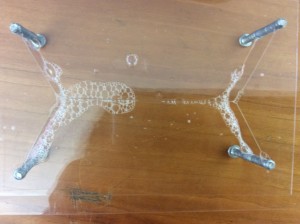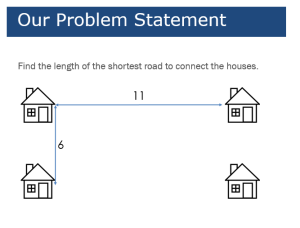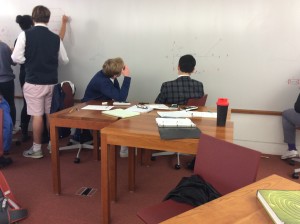I am so very lucky to have a guest teacher with me this year at my school. Maria Hernandez (from the North Carolina School of Science and Math) is probably one of the most energetic and knowledgeable teachers, speakers and mathematicians you could ever find – and we got her for the whole year! We are so excited. I am working with her and she is so much fun to work with. I have been teaching calculus with PBL for almost 20 years now and thought I had all the fun I could but no! Maria is bringing modeling into my curriculum and I’m enjoying every minute of it.
As we started teaching optimization this week, Maria had this wonderful idea that she had done before where we want to find the shortest path that connects four houses.
I let the kids play with this for about 10 minutes and then did this wonderful demonstration with some liquid soap bubbles and glycerin. We had two pieces of plastic and four screws that represented the houses. As the kids watched, I dipped the plastic frame into the liquid and voila-
Right away the students saw what they were looking for in the shortest path. Now they had to come up with the function and do some calculus. As they talked and worked in groups, It was clear that using a variable or one that would help them create the right function was not as easy as they thought. However, I was requiring them to write up what they were doing and find a solution so they were working hard.
We have been doing a lot of writing in Calculus this fall so far and they are getting used to being deliberate about their words and articulating their ideas in mathematical ways.
Here is the outline of the work they did in class: Shortest Path Lab
and here is the rubric that I will be using to grade it.
The engagement of students and the buzz of the classroom was enough to let me know that this type of problem was interesting enough to them – more than the traditional “fold up the sides of the box.” The experience they had in conjecturing, viewing, writing the algebra and solving with calculus was a true modeling experience.
If you decide to do this problem or have done something like it before, please share – I’d love to do more like this. I am very lucky to have a live-in PD person with me this year and am grateful every day for Maria!


